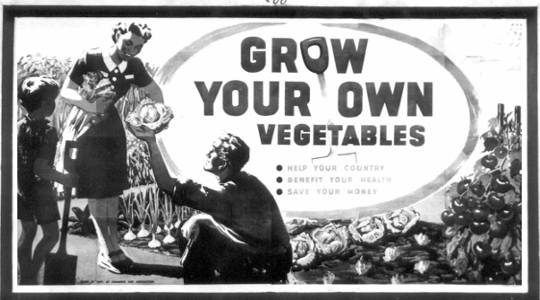
During the devastating floods that hit Queensland in 2011, Brisbane and regional centres came perilously close to running out of fresh food. With the central Rocklea produce market underwater, panic-buying soon set in and supermarket shelves emptied fast.
Such events expose the vulnerability of our urban food systems. Climate change and resource depletion present more slow-burning challenges, but the fact remains that urban food policy is at risk of complacency.
Gardening is certainly good for you, but does it have a role to play in increasing urban food security and resilience? Perhaps history can tell us the answer.
While Australian research has focused on recent urban agriculture initiatives, a real-world experiment in gardening for food security took place in Australia more than 70 years ago, during the Second World War.
Winning the war with home-grown food
Britain, facing serious food shortages, began using the slogan “Dig for Victory” in 1939. In Australia, low-key efforts at encouraging home food production began two years later.
A 1941 survey of Melbourne households revealed that 48% of them already produced food of some kind. In spacious middle-ring suburbs the proportion was as high as 88%, whereas in the dense inner cities it was less than 15%. Food production was most common among middle-class and skilled working-class households, and less so among the poor and marginalised.
By 1943, significant food shortfalls were expected in Australia. The government responded with a range of measures, including a large-scale “Grow Your Own” campaign.
Movies, radio broadcasts, public demonstrations, competitions, posters, newspaper ads and brochures all urged home gardeners to grow their own vegetables. It was hoped this would reduce the strain on the commercial food supply, as well as offering substitutes for rationed food items, providing insurance against commercial food supply failures, and easing the demand on items such as fuel and rubber. Municipal councils and schools also ran vegetable production programmes.
While there are no reliable statistics on the campaign’s effectiveness, anecdotal evidence suggests that home food production increased – but not without hitting obstacles along the way.
Wartime disruptions led to shortages of pesticides, seeds, rubber and fertilisers. Livestock and fowl can play an important role in nutrient cycling in sustainable food production, but cows and goats had been excluded from many urban areas in the decades before the war. As a result, competition for local manure was fierce; some gardeners would wait with bucket and shovel for horses on grocery rounds to pass by.
Artificial fertilisers were also expensive and hard to come by. Even the use of blood and bone as an organic fertiliser was restricted, as it was diverted for commercial poultry and pig feed. Alternatives included composting of waste, although this required time and skill, and its nutritional value for plants was limited.
Labour, too, was in short supply. Many able-bodied people had joined the armed forces and others were working long hours in war jobs. This left relatively few urban residents with the time and energy to devote to a vegetable garden. The Women’s Land Army was involved in some urban cultivation, and the YWCA established a “Garden Army” of women who established and tended community gardens on private or public land.
Lessons from the past
What lessons can we learn from this history about the capacity for suburban food production to boost urban food supply in a time of prolonged scarcity?
The most important is that home and community food gardens can contribute meaningfully to resilient urban food systems, but as our urban form is changing we need to explicitly plan for this contribution.
For example, vegetable gardens need space – public or private – that is reasonably open and not crowded by trees. This is one reason why the spacious middle-ring suburbs of Melbourne were more productive than the inner city in 1941.
Sustainable urban food production also requires skill, knowledge and time. Much food gardening today relies heavily on purchased seedlings, manures and pesticides. Resilient food gardens need to have a range of strategies for sourcing essential inputs locally, for example through seed saving networks, composting, local livestock and fowl, and on-site rainwater collection and storage. They also need people with the time and skills to manage these systems.
This history also provides inspiration in the form of stories of self-provisioning by everyday people, such as the 56-year-old woman running a habadashery and confectionery store who in 1941 produced all the vegetables and eggs she and her sister required at their Essendon home.
The low-density form of much of Australia’s urban landscape provides considerable potential for sustainable and resilient food production. But our cities still need to invest in developing the skills and systems to sustain this kind of farming.
This is especially critical for low-income areas where resource scarcity will bite hardest. It is also a task that looks ever more challenging as farms are pushed further from the city, while standard homes on shrinking lot sizes and poorly designed infill development eat up urban garden space.
We may not yet be at the stage of needing a nationwide “Grow Your Own” campaign on the scale seen during wartime. But if we want to increase our cities’ resilience and sustainability, we would be foolish to ignore its lessons.
![]()
About The Author
Andrea Gaynor, Associate Professor of History, University of Western Australia
This article was originally published on The Conversation. Read the original article.
Related Books:
at InnerSelf Market and Amazon























